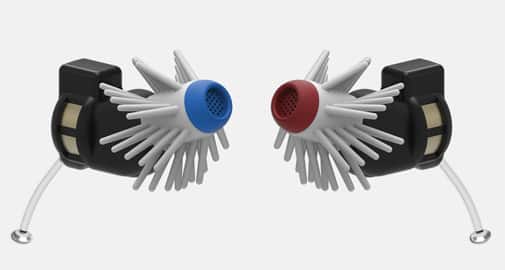6 Startups Working on How to Fix Hearing Loss
Table of contents

We find ourselves spending less time in the pub these days. Not because we don’t like to drink anymore—on the contrary, we have more reasons than ever to imbibe—but because it has become virtually impossible to carry on a conversation without going hoarse and spitting profusely into the listener’s ear in the process. The noise level in some of these places can reach up to 90 decibels, about the equivalent of talking to a lawnmower without the smell of freshly cut grass (unless you’re doing shots of Jägermeister). Add in all of those heavy metal concerts of our wayward youth, and it’s surprising we can even hear a gunshot in Chicago on a holiday weekend.
Hearing loss affects about 15 percent of the adult population in the United States, according to statistics compiled by the National Institutes of Health on Deafness and other Communication Disorders. Nearly 30 million people in the United States alone could benefit from hearing aids but most just opt to scream “What!?!” louder instead, whether it’s because a pair of high-quality hearing aids can set you back $10,000 or they just assume it’s what happens when you get older (the popularity of Viagra illustrating where we have our priorities).
We’ve recently come across a number of startups that have developed high-tech hearing aids, sometimes called hearables in the consumer sector, novel medical therapies and even specialized messaging technology for the hearing impaired. We first covered this topic of high-tech hearing aids with a startup called Doppler Labs, which had produced a device called Here One, a wearable audio system designed to augment hearing by filtering out unwanted noises. It was one of the first low-cost hearing aids masquerading as a consumer electronics hearable. Unfortunately, the lights at the San Francisco startup just went dark this week, as the company called it quits after burning through about $51 million.
That means one less competitor for these six startups.
Everything’s Better with Lasers

Fishing for Sounds

The Eargo Plus hearing aid is shaped like a fishing fly and is nearly the same size, suspended in the middle of the ear using soft medical grade silicone fibers. The so-called Flexi Fibers don’t plug the ear canal, allowing some ambient bass sounds to pass through, while the device mainly amplifies the mid and high sounds. The company says it’s like having an “internal equalizer set just right”.
Update 03/05/2019: Eargo has raised $52 million in Series D funding to continuing crafting and innovating new products targeting baby boomers. This brings the company’s total funding to $135.6 million to date.

The rechargeable hearing aids, which retail for $1,999 a pair, also come with four sound profiles that work for most people with mild or moderate hearing loss. The wearer can change volume and sound profiles with a gentle double tap on the ear.
Hearables as a High-Tech Hearing Aid

As possible high-tech hearing aids, IQbuds allow users to mute background noise, while accentuating the speech frequencies of those seated nearby. The company is also promoting the device as a way to help those with auditory and concentration disorders such as autism. You can pick up a set on Amazon for $299.
Ditch the Device Altogether
Even the coolest-looking hearing aid or wearable is still an instrument that can break, malfunction or even be lost down the kitchen drain. Why not just cure hearing loss and ditch the device altogether? A couple of biotech startups are working to do just that.

Update 11/09/2020: Decibel Therapeutics has raised $82 million in Series D funding to propel its lead programs into and through the clinic. This brings the company’s total funding to $189 million to date.

Its work is based on the research of its founders into inner ear pathology. Their research suggests that the dysfunctions related to the synapse (a junction between two nerve cells) in the ear may be linked to many of the major hearing disorders. Decibel’s scientific platform is focused on restoring the synapse.
Also founded in 2015 and headquartered just a few miles north of Boston in Woburn, Frequency Therapeutics raised $32 million in a Series A in April. The company is developing small molecule drugs that activate what are called progenitor cells, sort of like stem cells, within the body to restore healthy tissue. Its initial target is to regrow sensory cells in the inner ear to treat noise-induced hearing loss. Basically, the drugs under development would help dormant inner ear progenitor cells to multiply and create new hair cells. Frequency Therapeutics says drugs targeting progenitor cells may also help with skin disorders, muscle regeneration and gastrointestinal diseases.
Update 01/10/2019: Frequency Therapeutics raised an additional $42 million in Series B funding led by Taiwania Capital Management to advance their lead hearing program into Phase 2 studies in 2019 and help support the continued expansion of Frequency’s pipeline with new therapeutic applications. This brings the company’s total funding to $76 million to date.
Personalized Closed Captioning


The company says Ava employs artificial intelligence, as it gets better at recognizing specific voices over time, increasing the accuracy of the translation. The app is free to download but only comes with five hours of group captioning per month. It will cost users $29.99 per month to unlock unlimited group convos.
Conclusion
Here we offered you a snapshot of what startups are doing to help people overcome hearing disabilities. We suspect the big manufacturers of hearing aids will continue to dominate in the short term, but with the passage this year of the Over-the-Counter Hearing Aid Act, the door is now open to companies like Doppler Labs and Nuheara to blur the divide between hearing aid and hearable, which comes with some pretty cool features and much lower price points. As far as finding a cure for hearing loss, the biotech companies we highlighted are both very early stage, but Google-backed Decibel Therapeutics certainly warrants watching. Captioning technology like that developed by Ava may have a role to play, but we wouldn’t expect it to be widely adopted, especially at $360 a year for an app. Let us know if you hear differently.
Sign up to our newsletter to get more of our great research delivered straight to your inbox!
Nanalyze Weekly includes useful insights written by our team of underpaid MBAs, research on new disruptive technology stocks flying under the radar, and summaries of our recent research. Always 100% free.
















